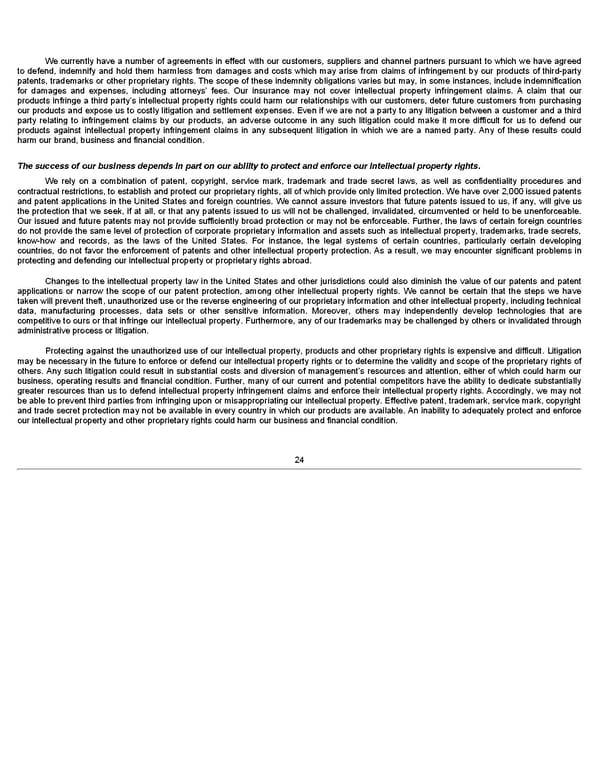We currently have a number of agreements in effect with our customers, suppliers and channel partners pursuant to which we have agreed to defend, indemnify and hold them harmless from damages and costs which may arise from claims of infringement by our products of third-party patents, trademarks or other proprietary rights. The scope of these indemnity obligations varies but may, in some instances, include indemnification for damages and expenses, including attorneys’ fees. Our insurance may not cover intellectual property infringement claims. A claim that our products infringe a third party’s intellectual property rights could harm our relationships with our customers, deter future customers from purchasing our products and expose us to costly litigation and settlement expenses. Even if we are not a party to any litigation between a customer and a third party relating to infringement claims by our products, an adverse outcome in any such litigation could make it more difficult for us to defend our products against intellectual property infringement claims in any subsequent litigation in which we are a named party. Any of these results could harm our brand, business and financial condition. The success of our business depends in part on our ability to protect and enforce our intellectual property rights. We rely on a combination of patent, copyright, service mark, trademark and trade secret laws, as well as confidentiality procedures and contractual restrictions, to establish and protect our proprietary rights, all of which provide only limited protection. We have over 2,000 issued patents and patent applications in the United States and foreign countries. We cannot assure investors that future patents issued to us, if any, will give us the protection that we seek, if at all, or that any patents issued to us will not be challenged, invalidated, circumvented or held to be unenforceable. Our issued and future patents may not provide sufficiently broad protection or may not be enforceable. Further, the laws of certain foreign countries do not provide the same level of protection of corporate proprietary information and assets such as intellectual property, trademarks, trade secrets, know-how and records, as the laws of the United States. For instance, the legal systems of certain countries, particularly certain developing countries, do not favor the enforcement of patents and other intellectual property protection. As a result, we may encounter significant problems in protecting and defending our intellectual property or proprietary rights abroad. Changes to the intellectual property law in the United States and other jurisdictions could also diminish the value of our patents and patent applications or narrow the scope of our patent protection, among other intellectual property rights. We cannot be certain that the steps we have taken will prevent theft, unauthorized use or the reverse engineering of our proprietary information and other intellectual property, including technical data, manufacturing processes, data sets or other sensitive information. Moreover, others may independently develop technologies that are competitive to ours or that infringe our intellectual property. Furthermore, any of our trademarks may be challenged by others or invalidated through administrative process or litigation. Protecting against the unauthorized use of our intellectual property, products and other proprietary rights is expensive and difficult. Litigation may be necessary in the future to enforce or defend our intellectual property rights or to determine the validity and scope of the proprietary rights of others. Any such litigation could result in substantial costs and diversion of management’s resources and attention, either of which could harm our business, operating results and financial condition. Further, many of our current and potential competitors have the ability to dedicate substantially greater resources than us to defend intellectual property infringement claims and enforce their intellectual property rights. Accordingly, we may not be able to prevent third parties from infringing upon or misappropriating our intellectual property. Effective patent, trademark, service mark, copyright and trade secret protection may not be available in every country in which our products are available. An inability to adequately protect and enforce our intellectual property and other proprietary rights could harm our business and financial condition. 24
 Annua lReport Page 23 Page 25
Annua lReport Page 23 Page 25